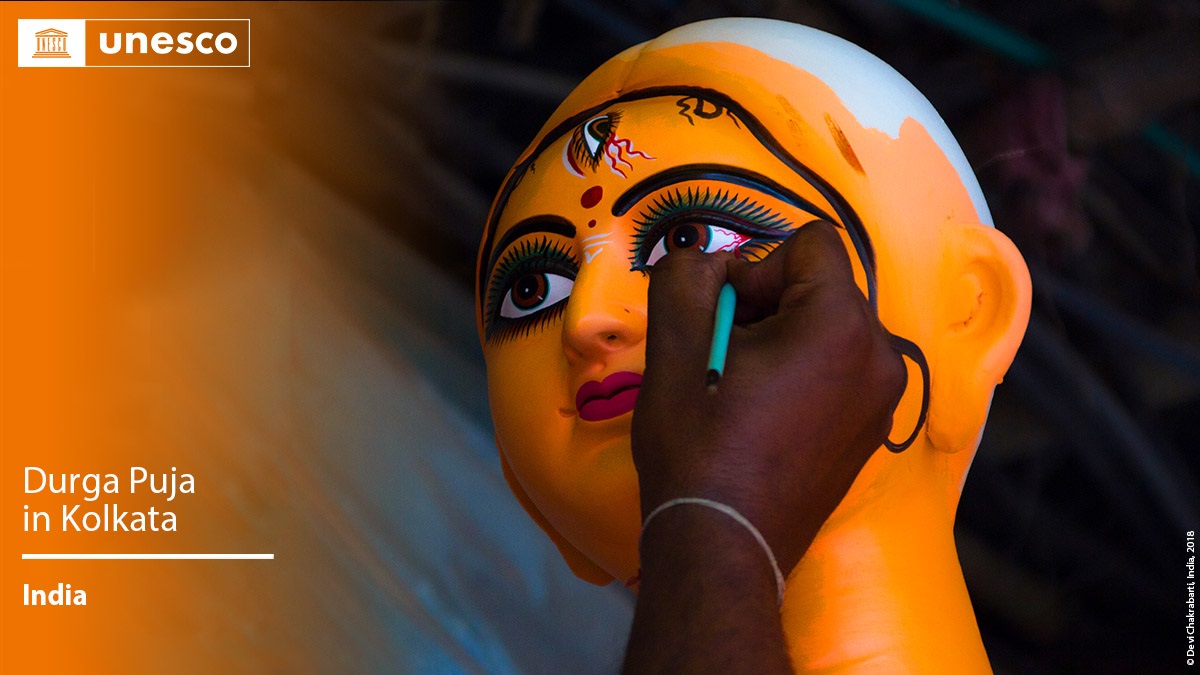India & World UpdatesHappeningsBreaking News
Durga Puja of Kolkata wins Heritage Status from UNESCO

Dec. 15: In what seems to be a pride for not only the Bengalis of West Bengal but for the people of India as a nation is that, United Nations Educational, Scientific and Cultural Organisation (UNESCO) has listed Durga Puja of Kolkata in its Intangible Heritage List. Taking to its official twitter handle on 15 December, 2021, UNESCO wrote, “BREAKING Durga Puja in Kolkata has just been inscribed on the #IntangibleHeritage list. Congratulations #India !”
 Expressing his reaction, Union Minister Piyush Goyal wrote on twitter, “Proud moment for Indians & the City of Joy! Kolkata’s iconic Durga Puja inscribed on the @UNESCO‘s #IntangibleHeritage list. Every year, the grand celebration of the auspicious festival becomes a sight to behold showcasing the cultural glory of India.
Expressing his reaction, Union Minister Piyush Goyal wrote on twitter, “Proud moment for Indians & the City of Joy! Kolkata’s iconic Durga Puja inscribed on the @UNESCO‘s #IntangibleHeritage list. Every year, the grand celebration of the auspicious festival becomes a sight to behold showcasing the cultural glory of India. .”
BREAKING
Durga Puja in Kolkata has just been inscribed on the #IntangibleHeritage list.
Congratulations #India
!
https://t.co/gkiPLq3P0F #LivingHeritage pic.twitter.com/pdQdcf33kT
— UNESCO
#Education #Sciences #Culture
(@UNESCO) December 15, 2021
BJP President JP Nadda said, “Kolkata’s grand Durga Puja celebration brings glory to India as it gets inscribed on the UNESCO’s #IntangibleHeritage list. The pious festival of Durga Puja displays India’s rich cultural heritage & traditions. A proud moment for every Indian.”
 Elaborating on the Durga Puja festival, UNESCO in its Intangible Cultural Heritage page wrote, “Durga Puja is an annual festival celebrated in September or October, most notably in Kolkata, in West Bengal of India, but also in other parts of India and amongst the Bengali diaspora. It marks the ten-day worship of the Hindu mother-goddess Durga. In the months preceding the festival, small artisanal workshops sculpt images of Durga and her family using unfired clay pulled from the Ganga River. The worship of the goddess then begins on the inaugural day of Mahalaya, when eyes are painted onto the clay images to bring the goddess to life. It ends on the tenth day, when the images are immersed in the river from where the clay came. Thus, the festival has also come to signify ‘home-coming’ or a seasonal return to one’s roots. Durga Puja is seen as the best instance of the public performance of religion and art, and as a thriving ground for collaborative artists and designers. The festival is characterized by large-scale installations and pavilions in urban areas, as well as by traditional Bengali drumming and veneration of the goddess. During the event, the divides of class, religion and ethnicities collapse as crowds of spectators walk around to admire the installations.”
Elaborating on the Durga Puja festival, UNESCO in its Intangible Cultural Heritage page wrote, “Durga Puja is an annual festival celebrated in September or October, most notably in Kolkata, in West Bengal of India, but also in other parts of India and amongst the Bengali diaspora. It marks the ten-day worship of the Hindu mother-goddess Durga. In the months preceding the festival, small artisanal workshops sculpt images of Durga and her family using unfired clay pulled from the Ganga River. The worship of the goddess then begins on the inaugural day of Mahalaya, when eyes are painted onto the clay images to bring the goddess to life. It ends on the tenth day, when the images are immersed in the river from where the clay came. Thus, the festival has also come to signify ‘home-coming’ or a seasonal return to one’s roots. Durga Puja is seen as the best instance of the public performance of religion and art, and as a thriving ground for collaborative artists and designers. The festival is characterized by large-scale installations and pavilions in urban areas, as well as by traditional Bengali drumming and veneration of the goddess. During the event, the divides of class, religion and ethnicities collapse as crowds of spectators walk around to admire the installations.”







